Abstract
Marek's disease herpesvirus (MDV)-transformed lymphoblastoid tumor cell lines were characterized for the presence of the surface markers. Monoclonal antibodies were used for CD3 (T-cell receptor [TCR] complex), TCR1, TCR2, and TCR3, CD4, CD8, and Ia antigen by indirect fluorescence staining followed by microscopic examination or flow cytometry. The lymphoblastoid cell lines were obtained from tumors from chickens infected with MDV (n = 44) or from local lesions induced by inoculation of allogeneic, MDV-infected chick kidney cells (n = 56). Lymphocytes were harvested from these lesions between 4 and 16 days postinoculation and cultured in vitro to establish cell lines. All cell lines expressed Ia antigen and CD3 and/or TCR and thus are activated T cells. Most of the cell lines developed from tumors were CD4+ CD8-; only one cell line was negative for both markers. Sixteen percent of the cell lines were TCR3+, while the remainder were TCR2+. The cell lines developed from local lesions were much more heterogeneous: 45% were CD4- CD8+, 34% were CD4- CD8-, and only 21% were CD4+ CD8-. The number of TCR3+ cell lines was larger than expected for the CD4- CD8+ and CD4- CD8- cell lines, as judged from the presence of these cells in the blood. These results indicate that several subsets of T lymphocytes can be transformed by MDV, depending on the pathogenesis of infection. Activation of T cells as a consequence of the normal pathogenesis or by allogeneic stimulation seem to be a first important step in the process of transformation.
Full text
PDF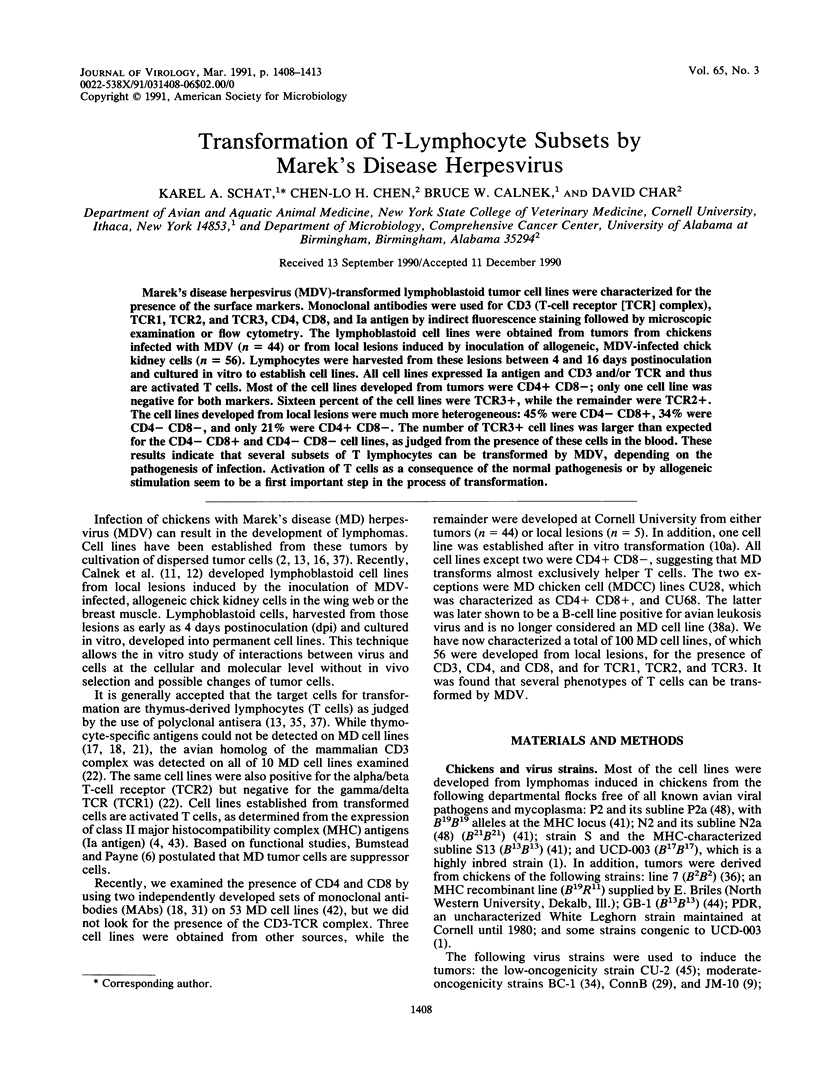
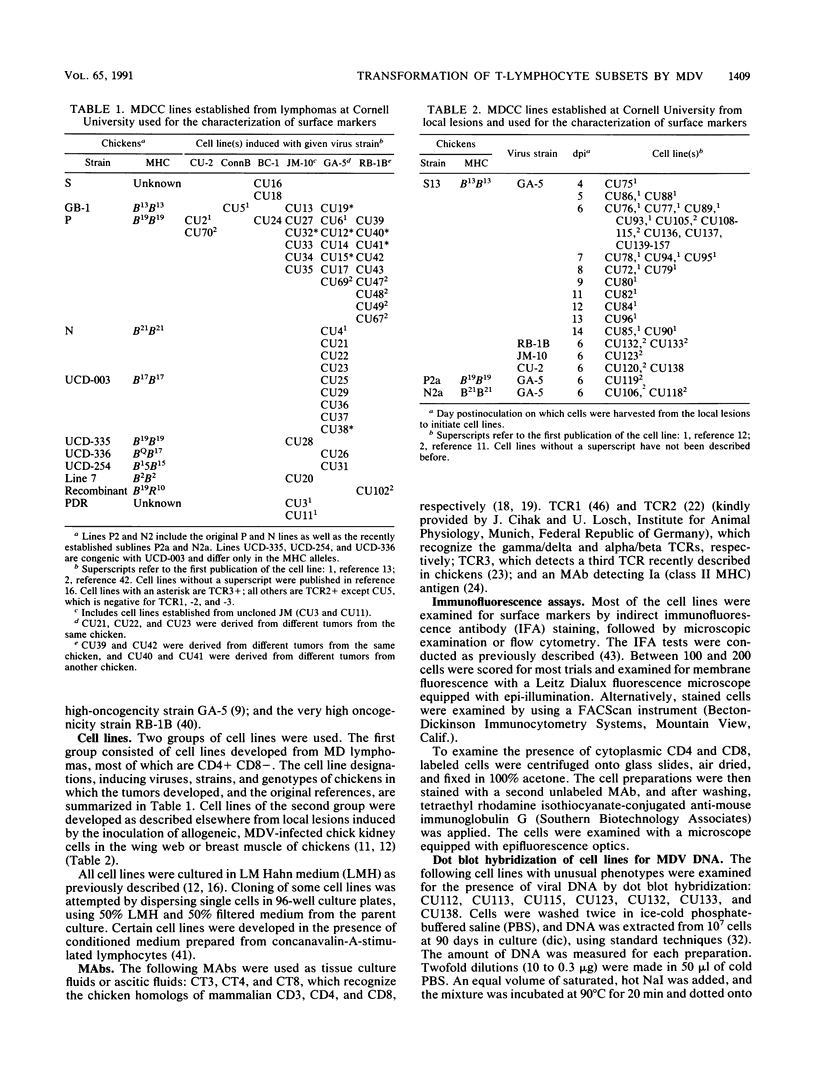
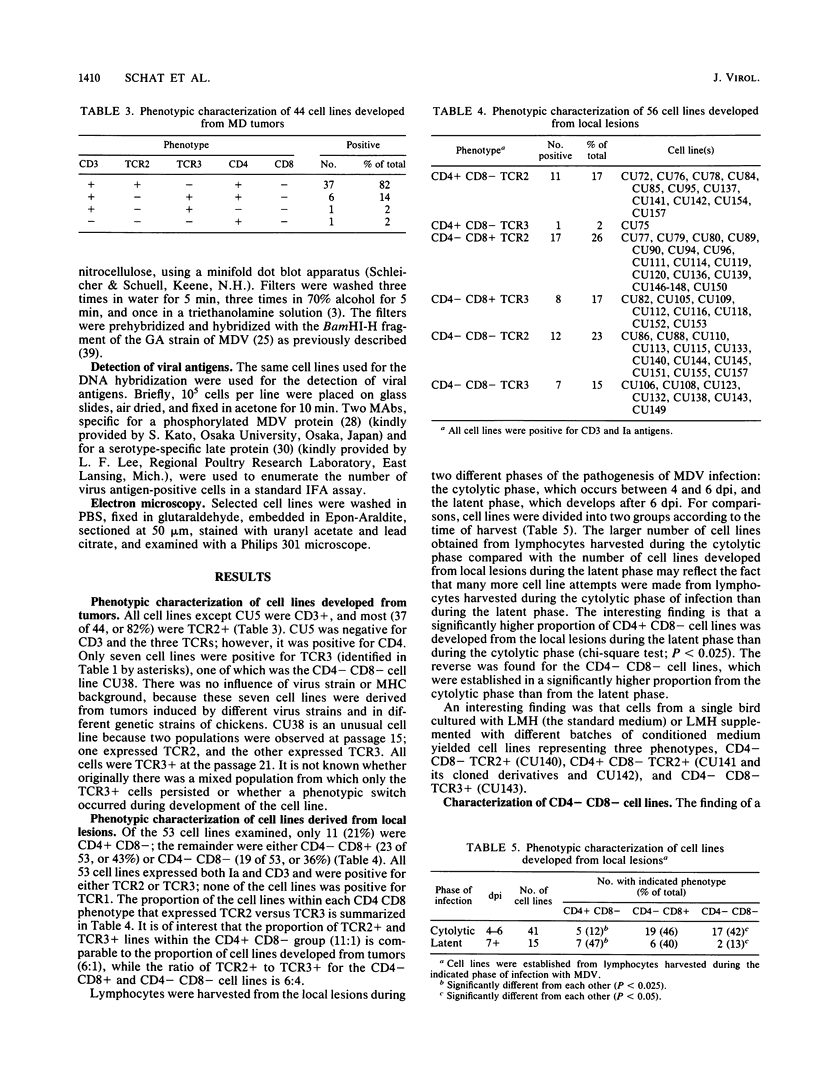
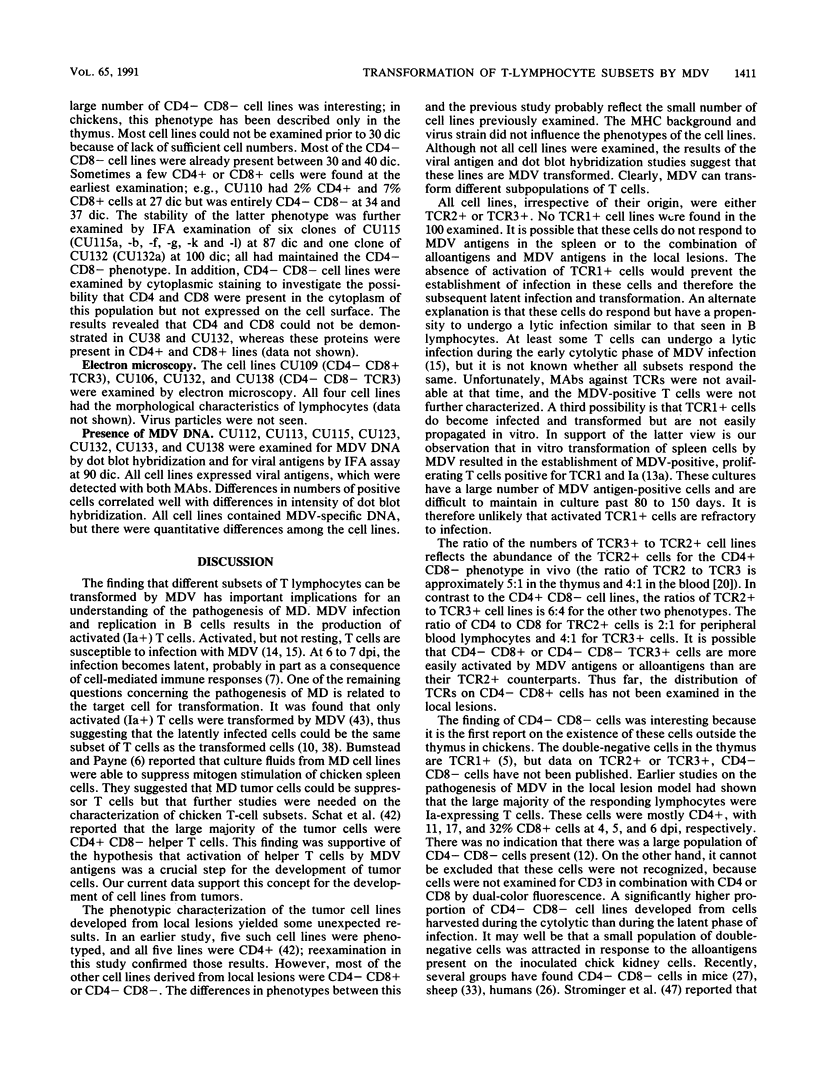

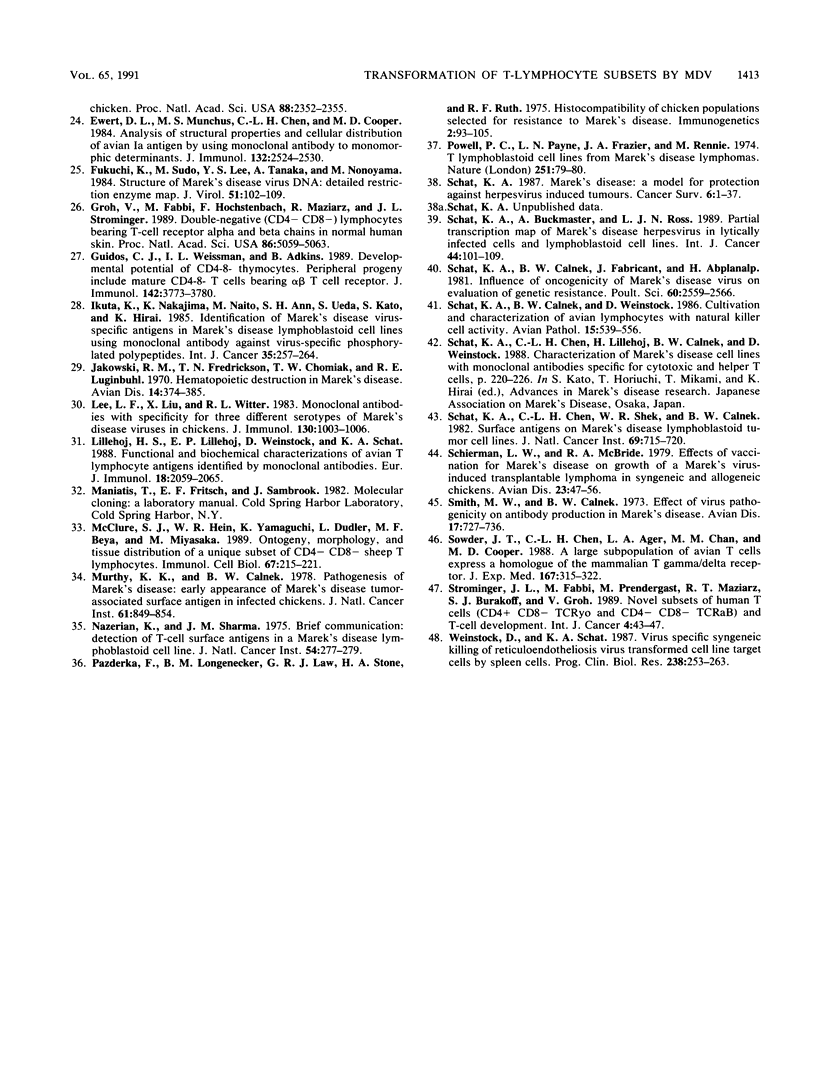
Selected References
These references are in PubMed. This may not be the complete list of references from this article.
- Akiyama Y., Kato S. Two cell lines from lymphomas of Marek's disease. Biken J. 1974 Sep;17(3):105–116. [PubMed] [Google Scholar]
- Bresser J., Doering J., Gillespie D. Quick-blot: selective mRNA or DNA immobilization from whole cells. DNA. 1983;2(3):243–254. doi: 10.1089/dna.1983.2.243. [DOI] [PubMed] [Google Scholar]
- Bucy R. P., Chen C. H., Cooper M. D. Ontogeny of T cell receptors in the chicken thymus. J Immunol. 1990 Feb 15;144(4):1161–1168. [PubMed] [Google Scholar]
- Bumstead J. M., Payne L. N. Production of an immune suppressor factor by Marek's disease lymphoblastoid cell lines. Vet Immunol Immunopathol. 1987 Sep;16(1-2):47–66. doi: 10.1016/0165-2427(87)90173-5. [DOI] [PubMed] [Google Scholar]
- Buscaglia C., Calnek B. W., Schat K. A. Effect of immunocompetence on the establishment and maintenance of latency with Marek's disease herpesvirus. J Gen Virol. 1988 May;69(Pt 5):1067–1077. doi: 10.1099/0022-1317-69-5-1067. [DOI] [PubMed] [Google Scholar]
- Caballero A., Garrido A., Algarra I., Perez M., Garrido F. Generation of syngeneic anti-tumour double negative cells (CD4- CD8-), with cytotoxic activity against clones of different MHC class I expression. J Immunogenet. 1989 Aug-Oct;16(4-5):321–328. doi: 10.1111/j.1744-313x.1989.tb00478.x. [DOI] [PubMed] [Google Scholar]
- Calnek B. W. Influence of age at exposure on the pathogenesis of Marek's disease. J Natl Cancer Inst. 1973 Sep;51(3):929–939. doi: 10.1093/jnci/51.3.929. [DOI] [PubMed] [Google Scholar]
- Calnek B. W., Lucio B., Schat K. A., Lillehoj H. S. Pathogenesis of Marek's disease virus-induced local lesions. 1. Lesion characterization and cell line establishment. Avian Dis. 1989 Apr-Jun;33(2):291–302. [PubMed] [Google Scholar]
- Calnek B. W. Marek's disease--a model for herpesvirus oncology. Crit Rev Microbiol. 1986;12(4):293–320. doi: 10.3109/10408418509104432. [DOI] [PubMed] [Google Scholar]
- Calnek B. W., Murthy K. K., Schat K. A. Establishment of Marek's disease lymphoblastoid cell lines from transplantable versus primary lymphomas. Int J Cancer. 1978 Jan 15;21(1):100–107. doi: 10.1002/ijc.2910210117. [DOI] [PubMed] [Google Scholar]
- Calnek B. W., Schat K. A., Ross L. J., Shek W. R., Chen C. L. Further characterization of Marek's disease virus-infected lymphocytes. I. In vivo infection. Int J Cancer. 1984 Mar 15;33(3):389–398. doi: 10.1002/ijc.2910330318. [DOI] [PubMed] [Google Scholar]
- Calnek B. W., Shek W. R., Schat K. A. Spontaneous and induced herpesvirus genome expression in Marek's disease tumor cell lines. Infect Immun. 1981 Nov;34(2):483–491. doi: 10.1128/iai.34.2.483-491.1981. [DOI] [PMC free article] [PubMed] [Google Scholar]
- Chan M. M., Chen C. L., Ager L. L., Cooper M. D. Identification of the avian homologues of mammalian CD4 and CD8 antigens. J Immunol. 1988 Apr 1;140(7):2133–2138. [PubMed] [Google Scholar]
- Chen C. H., Chanh T. C., Cooper M. D. Chicken thymocyte-specific antigen identified by monoclonal antibodies: ontogeny, tissue distribution and biochemical characterization. Eur J Immunol. 1984 May;14(5):385–391. doi: 10.1002/eji.1830140502. [DOI] [PubMed] [Google Scholar]
- Chen C. H., Sowder J. T., Lahti J. M., Cihak J., Lösch U., Cooper M. D. TCR3: a third T-cell receptor in the chicken. Proc Natl Acad Sci U S A. 1989 Apr;86(7):2351–2355. doi: 10.1073/pnas.86.7.2351. [DOI] [PMC free article] [PubMed] [Google Scholar]
- Chen C. L., Ager L. L., Gartland G. L., Cooper M. D. Identification of a T3/T cell receptor complex in chickens. J Exp Med. 1986 Jul 1;164(1):375–380. doi: 10.1084/jem.164.1.375. [DOI] [PMC free article] [PubMed] [Google Scholar]
- Chen C. L., Bucy R. P., Cooper M. D. T cell differentiation in birds. Semin Immunol. 1990 Jan;2(1):79–86. [PubMed] [Google Scholar]
- Chen C. L., Cihak J., Lösch U., Cooper M. D. Differential expression of two T cell receptors, TcR1 and TcR2, on chicken lymphocytes. Eur J Immunol. 1988 Apr;18(4):539–543. doi: 10.1002/eji.1830180408. [DOI] [PubMed] [Google Scholar]
- Ewert D. L., Munchus M. S., Chen C. L., Cooper M. D. Analysis of structural properties and cellular distribution of avian Ia antigen by using monoclonal antibody to monomorphic determinants. J Immunol. 1984 May;132(5):2524–2530. [PubMed] [Google Scholar]
- Fukuchi K., Sudo M., Lee Y. S., Tanaka A., Nonoyama M. Structure of Marek's disease virus DNA: detailed restriction enzyme map. J Virol. 1984 Jul;51(1):102–109. doi: 10.1128/jvi.51.1.102-109.1984. [DOI] [PMC free article] [PubMed] [Google Scholar]
- Groh V., Fabbi M., Hochstenbach F., Maziarz R. T., Strominger J. L. Double-negative (CD4-CD8-) lymphocytes bearing T-cell receptor alpha and beta chains in normal human skin. Proc Natl Acad Sci U S A. 1989 Jul;86(13):5059–5063. doi: 10.1073/pnas.86.13.5059. [DOI] [PMC free article] [PubMed] [Google Scholar]
- Guidos C. J., Weissman I. L., Adkins B. Developmental potential of CD4-8- thymocytes. Peripheral progeny include mature CD4-8- T cells bearing alpha beta T cell receptor. J Immunol. 1989 Jun 1;142(11):3773–3780. [PubMed] [Google Scholar]
- Ikuta K., Nakajima K., Naito M., Ann S. H., Ueda S., Kato S., Hirai K. Identification of Marek's disease virus-specific antigens in Marek's disease lymphoblastoid cell lines using monoclonal antibody against virus-specific phosphorylated polypeptides. Int J Cancer. 1985 Feb 15;35(2):257–264. doi: 10.1002/ijc.2910350219. [DOI] [PubMed] [Google Scholar]
- Jakowski R. M., Fredrickson T. N., Chomiak T. W., Luginbuhl R. E. Hematopoietic destruction in Marek's disease. Avian Dis. 1970 May;14(2):374–385. [PubMed] [Google Scholar]
- Lee L. F., Liu X., Witter R. L. Monoclonal antibodies with specificity for three different serotypes of Marek's disease viruses in chickens. J Immunol. 1983 Feb;130(2):1003–1006. [PubMed] [Google Scholar]
- Lillehoj H. S., Lillehoj E. P., Weinstock D., Schat K. A. Functional and biochemical characterizations of avian T lymphocyte antigens identified by monoclonal antibodies. Eur J Immunol. 1988 Dec;18(12):2059–2065. doi: 10.1002/eji.1830181228. [DOI] [PubMed] [Google Scholar]
- McClure S. J., Hein W. R., Yamaguchi K., Dudler L., Beya M. F., Miyasaka M. Ontogeny, morphology and tissue distribution of a unique subset of CD4-CD8- sheep T lymphocytes. Immunol Cell Biol. 1989 Aug;67(Pt 4):215–221. doi: 10.1038/icb.1989.33. [DOI] [PubMed] [Google Scholar]
- Murthy K. K., Calnek B. W. Pathogenesis of Marek's disease: early appearance of Marek's disease tumor-associated surface antigen in infected chickens. J Natl Cancer Inst. 1978 Sep;61(3):849–854. [PubMed] [Google Scholar]
- Nazerian K., Sharma J. M. Detection of T-cell surface antigens in a Marek's disease lymphoblastoid cell line. J Natl Cancer Inst. 1975 Jan;54(1):277–279. doi: 10.1093/jnci/54.1.277. [DOI] [PubMed] [Google Scholar]
- Powell P. C., Payne L. N., Frazier J. A., Rennie M. T lymphoblastoid cell lines from Marek's disease lymphomas. Nature. 1974 Sep 6;251(5470):79–80. doi: 10.1038/251079a0. [DOI] [PubMed] [Google Scholar]
- Schat K. A., Buckmaster A., Ross L. J. Partial transcription map of Marek's disease herpesvirus in lytically infected cells and lymphoblastoid cell lines. Int J Cancer. 1989 Jul 15;44(1):101–109. doi: 10.1002/ijc.2910440119. [DOI] [PubMed] [Google Scholar]
- Schat K. A., Calnek B. W., Fabricant J., Abplanalp H. Influence of oncogenicity of Marek' disease virus on evaluation of genetic resistance. Poult Sci. 1981 Dec;60(12):2559–2566. doi: 10.3382/ps.0602559. [DOI] [PubMed] [Google Scholar]
- Schat K. A., Chen C. L., Shek W. R., Calnek B. W. Surface antigens on Marek's disease lymphoblastoid tumor cell lines. J Natl Cancer Inst. 1982 Sep;69(3):715–720. [PubMed] [Google Scholar]
- Schat K. A. Marek's disease: a model for protection against herpesvirus-induced tumours. Cancer Surv. 1987;6(1):1–37. [PubMed] [Google Scholar]
- Schierman L. W., McBride R. A. Effects of vaccination for Marek's disease on growth of a Marek's-virus-induced transplantable lymphoma in syngeneic and allogeneic chickens. Avian Dis. 1979 Jan-Mar;23(1):47–56. [PubMed] [Google Scholar]
- Smith M. W., Calnek B. W. Effect of virus pathogenicity on antibody production in Marek's disease. Avian Dis. 1973 Oct-Dec;17(4):727–736. [PubMed] [Google Scholar]
- Sowder J. T., Chen C. L., Ager L. L., Chan M. M., Cooper M. D. A large subpopulation of avian T cells express a homologue of the mammalian T gamma/delta receptor. J Exp Med. 1988 Feb 1;167(2):315–322. doi: 10.1084/jem.167.2.315. [DOI] [PMC free article] [PubMed] [Google Scholar]
- Strominger J. L., Fabbi M., Prendergast M., Maziarz R. T., Burakoff S. J., Groh V. Novel subsets of human T cells (CD4+ CD8- TCR gamma delta and CD4- CD8- TCR alpha beta) and T-cell development. Int J Cancer Suppl. 1989;4:43–47. [PubMed] [Google Scholar]
- Weinstock D., Schat K. A. Virus specific syngeneic killing of reticuloendotheliosis virus transformed cell line target cells by spleen cells. Prog Clin Biol Res. 1987;238:253–263. [PubMed] [Google Scholar]


